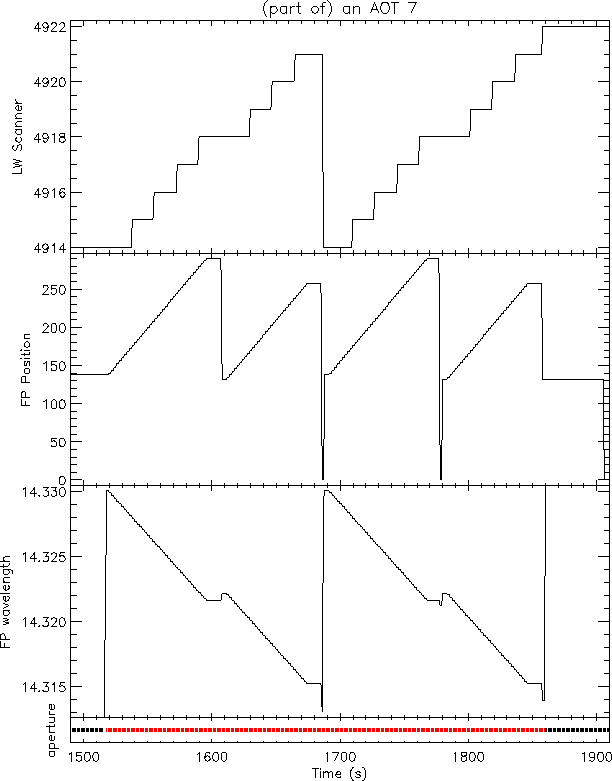SWS07 was the template used to take measurements using the Fabry-Pérot (FP). If requested, Short Wavelength grating observations of a type similar to those in SWS06 could be made in parallel.
For the FP the stepsize was always two FP units, about 1/4 of an FP wavelength resolution. Reset intervals were 1 or 2 seconds, with the dwell time equal to the reset interval. The number of scans was greater than, or equal to, three, and only up-scans were commanded.
Any requested SW grating observations were carried out in an identical manner to those of an SWS06 measurement, see Section 3.5.
Due to a slight internal misalignment of the Long Wave FP there were
problems merging FP observations with grating observations when
observing through aperture 3. The `effective'
aperture of the FP was displaced from the centre of the grating
aperture by approximately 10
![]() , causing an approximately
40% drop in throughput of the FP when pointing was determined by the
grating. The solution decided on was to define a fourth `effective'
aperture, centred on the FP aperture, and carry out
all observations through this. This meant the SW grating lost
approximately 40% of its throughput. Therefore LW FP observations (26
- 44
, causing an approximately
40% drop in throughput of the FP when pointing was determined by the
grating. The solution decided on was to define a fourth `effective'
aperture, centred on the FP aperture, and carry out
all observations through this. This meant the SW grating lost
approximately 40% of its throughput. Therefore LW FP observations (26
- 44![]() m) and SW grating observations (7.0 - 13.16
m) and SW grating observations (7.0 - 13.16![]() m)
through aperture 3 could not be merged. Any requested aperture 3
grating observations were performed after the FP observations. This
change was considered acceptable as the main purpose of SWS07 was FP
observations. Merging was still performed on observations using
apertures 1 or 2.
m)
through aperture 3 could not be merged. Any requested aperture 3
grating observations were performed after the FP observations. This
change was considered acceptable as the main purpose of SWS07 was FP
observations. Merging was still performed on observations using
apertures 1 or 2.
However, some early SWS07 observations were
carried out before this change was implemented, and the archive
contains observations containing FP data merged with SW grating
observations in the range 7 to 13.16![]() m.
m.
Example of an SWS07 observation:
The SWS07 was executed by pointing the telescope to the target position, where the observation was started with a dark current. The FP lines and grating wavelength ranges specified in the AOT were observed. Each FP line was scanned at least three times and each SW wavelength range was scanned at least twice to provide redundancy. Dark current measurements were performed at regular intervals, at least before and after a set of FP scans on the same line and at least once before the reference wavelength of each SW range. FP scans may had to be broken into segments because the end of the mechanical FP range was reached. Then the scan had to be continued in a different FP order. In all FP scans the LW grating was scanned slowly in coordination with the FP scan to keep the pre-dispersion tuned to the actual wavelength. If the line list contained wavelengths corresponding to different SWS apertures, the aperture was switched accordingly and the satellite re-pointed to bring the source to the centre of the new aperture. At regular intervals, between observations, photometric checks were performed, at least once per AOT.
Figure 3.12 shows the LW grating position, the FP position and the resulting wavelength of light falling on the detector during part of an SWS07 observation.
Figure 3.13 shows ERD, SPD
and aperture data for
part of an SWS07 observation. The ERD is shown as readouts
in bit values against time , and the SPD as signal (in ![]() V/s)
against time.
V/s)
against time.
Figure 3.14 shows SPD signal (![]() V/s) and
AAR
flux (Jy), both against wavelength, for the same period of the
example SWS07. Note the wavelength shift in
the location of the peak between the SPD and AAR. This is because the
SPD wavelength scale is `ISOcentric', whereas the AAR is corrected to
be heliocentric.
V/s) and
AAR
flux (Jy), both against wavelength, for the same period of the
example SWS07. Note the wavelength shift in
the location of the peak between the SPD and AAR. This is because the
SPD wavelength scale is `ISOcentric', whereas the AAR is corrected to
be heliocentric.

|

|